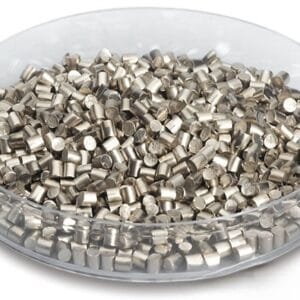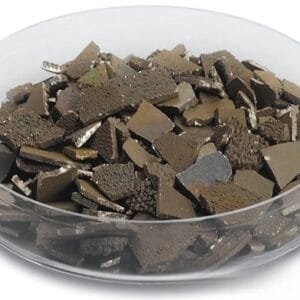| Material Type | CuZnSnS |
| Symbol | CuZnSnS |
| Melting Point (°C) | |
| Theoretical Density (g/cc) |
| Z Ratio | |
| E-Beam | |
| E-Beam Crucible Liner Material | |
| Temp. (°C) for Given Vap. Press. (Torr) | |
| Comments |
CuZnSnS Pellet Evaporation Material
TFM provides high-purity CuZnSnS Pellet Evaporation Material, an essential compound for thin-film deposition in photovoltaic, optoelectronic, and semiconductor applications. Composed of copper (Cu), zinc (Zn), tin (Sn), and sulfur (S), this material is widely used in the production of Cu₂ZnSnS₄ (CZTS) thin films, a promising alternative to traditional semiconductor materials for solar cell and energy-harvesting applications.
Designed for thermal evaporation and electron beam (E-beam) deposition, CuZnSnS ensures uniform film thickness, excellent purity, and strong adhesion, supporting high-efficiency energy conversion and advanced optoelectronic devices.
Key Features and Advantages
Eco-Friendly & Cost-Effective: CZTS is a non-toxic, earth-abundant material, making it a sustainable alternative to traditional cadmium- and tellurium-based semiconductors.
Excellent Light Absorption: Offers a direct bandgap (~1.4-1.5 eV), ideal for thin-film solar cells and energy-harvesting technologies.
High Purity & Uniform Deposition: Ensures consistent thin-film growth, improving device efficiency and performance.
Superior Thermal & Chemical Stability: Provides long-lasting performance in harsh environments, making it ideal for solar energy applications.
Customizable Composition: TFM offers tailored specifications to meet the needs of cutting-edge research and industrial production.
Applications
Thin-Film Solar Cells: Used in next-generation CZTS-based solar panels, providing a low-cost, high-efficiency alternative to silicon-based photovoltaics.
Optoelectronic Devices: Ideal for photoelectrochemical (PEC) cells, infrared detectors, and semiconductor components.
Energy Storage & Conversion: Plays a key role in photovoltaic energy conversion and sustainable energy research.
Thin-Film Deposition: Ensures high-quality coatings for optoelectronic applications and advanced semiconductor research.
Industry Impact and Customization
TFM’s CuZnSnS Pellet Evaporation Material is essential for developing high-performance thin-film solar cells and advanced semiconductor devices. With high purity, precise deposition control, and customizable formulations, TFM ensures its materials meet the demands of renewable energy research and next-generation optoelectronics.
By offering excellent light absorption, environmental sustainability, and cost-effective production, CuZnSnS Pellet Evaporation Material from TFM plays a key role in advancing solar energy technology and high-efficiency semiconductor applications.


 MSDS File
MSDS File



Reviews
There are no reviews yet.